Election Funding, Now What?
What has been mechanism of electoral funding in India (Before Introduction of Electoral bonds)?
The electoral funding In India has been done via 4 modes, Individual donations, State/Public Funding, Corporate Funding and Electoral trusts:-
1. Individual Donations
Section 29B of the Representation of the People Act (RPA) permits political parties to accept donations from individual persons.
Disclosure Requirement:- The Election Commission of India's Transparency Guidelines require the disclosure of donations over ₹20,000 (under the Representation of the People Act, 1951).
Receipt Issuance: As per the Representation of the People Act, 1951, political parties are mandated to issue receipts for every donation, which helps in maintaining a documented trail of contributions.
Anonymous Donations:- Section 13A of the Income Tax Act, 1961, limits anonymous cash donations to political parties to ₹2,000 to curb undisclosed funding.
Reporting to Election Commission: Under Section 29C of the Representation of the People Act, 1951, political parties must report details of donors who have contributed more than ₹20,000 in a financial year to the Election Commission of India.
Why Individuals donate the Political parties:- Section 80GGB of the Income Tax Act, 1961, allows individuals to claim deductions for donations made to political parties, promoting transparency while providing tax incentives for donors.
2. State/Public Funding
State funding of elections in India involves the government providing financial support to political parties and candidates, aiming to enhance transparency, fairness, and equal opportunity in the electoral process. This initiative seeks to diminish the influence of private donations and vested interests. Below is a structured summary of the various aspects of state funding, including the views of different commissions and arguments for and against this practice.
Types of State Funding
- Direct Funding: Monetary assistance directly to parties/candidates for campaign expenses.
- Indirect Funding: Includes subsidized media access, tax benefits, free public spaces for campaigns, and support for utilities, transport, and security.
Status in India
- Existing Measures: Free airtime on public broadcasters for parties, security, office space, and utility subsidies for national parties, income tax exemption for registered political parties.
Commissions on State Funding
- Indrajit Gupta Committee (1998): Supported state funding to level the playing field for all parties.
- Law Commission of India (1999): Advocated for total state funding, conditional on parties not accepting other funds.
- Second Administrative Reforms Commission (2008): Recommended partial state funding to reduce undue financial influence.
- National Commission to Review the Working of the Constitution (2001): Did not endorse state funding without a regulatory framework for political parties.
Arguments for State Funding
- Leveling the Playing Field: Allows parties to compete on ideas rather than financial clout.
- Reducing Corruption: Decreases reliance on private donations, reducing corrupt practices.
- Promoting Fair Competition: Ensures no undue advantage is based on financial resources.
- Strengthening Political Parties: Provides financial stability, focusing on policy over fundraising.
- Encouraging diverse representation: By providing financial support to all parties, state funding can promote political diversity and encourage a wide range of candidates to participate in elections. It can help reduce barriers to entry and support candidates from marginalized communities, women.
Arguments Against State Funding
- Burden on Taxpayers: Places additional financial responsibility on the public.
- Potential for Misuse: Concerns over the diversion of funds and political manipulation.
- Risk of Dependency: May reduce parties' financial independence and grassroots engagement.
- Challenges in Implementation: Difficulties in equitable distribution, establishing eligibility, and ensuring accountability.
3. Corporate Funding
- Governed under Section 182 of the Companies Act, 2013.
- Conditions for Donation:
- Companies must be at least three years old.
- Donations are capped at 7.5% of the average net profits made during the three immediately preceding financial years.
- Contributions must be disclosed in the company’s profit and loss account.
- Approval from the Board of Directors is required.
- Penalties: Violations can result in fines up to five times the amount contributed, and involved officers may face imprisonment of up to six months.
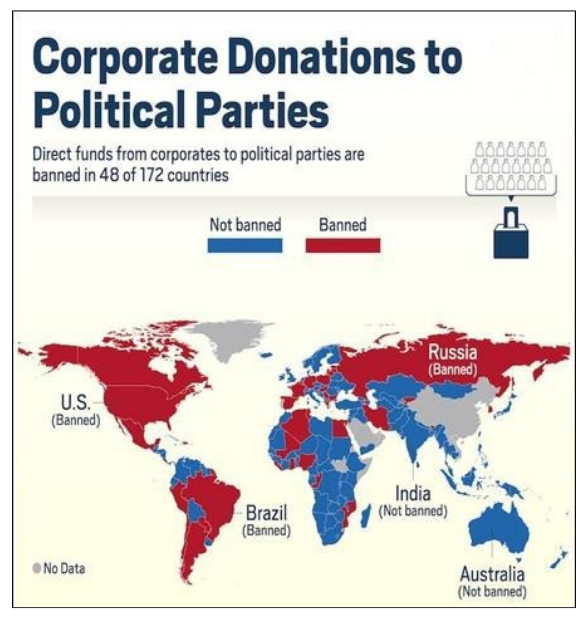
Historical Context of Corporate Funding:-
- Early Instances: Corporate funding dates back to the freedom movement, with the Birlas being notable donors to the Indian National Congress (INC).
- Post-Independence Influence: The 1960s saw significant corporate donations to political parties, notably the Congress and the Swatantra Party, from major companies like Tatas and Birlas.
Regulatory Shifts
- 1969 Ban: Indira Gandhi's government banned corporate funding to combat the nexus between business and politics, leading to alternative fundraising methods like souvenir publications.
- 1985 Reintroduction: Rajiv Gandhi lifted the ban, reintroducing corporate funding into Indian politics.
Liberalization and Its Aftermath
- Post-1991 Economic Reforms: The liberalization era marked a significant increase in corporate funding, facilitated by the introduction of electoral trusts and a focus on policy manipulation to favor corporate interests.
- Legislative Changes: Amendments to the Companies Act in 2013 and 2017, and changes to the Foreign Contribution Regulation Act (FCRA), facilitated increased corporate contributions and foreign investments in political funding.
Concerns and Criticisms
- Corruption and Favoritism: There's a growing concern that corporate funding leads to policies favoring big donors at the expense of the public interest.
- Influence on Policy: Policies like corporate tax exemptions and loan waivers indicate a government inclination towards corporate interests.
- Rise in White Collar Crimes: A correlation between corporate funding and an increase in corporate crimes, with notable scams including the 2G Spectrum Scam, Satyam Scam, and Coal Scam.
International Perspective
- United States: Supreme Court decisions have allowed unlimited corporate contributions, leading to concerns about plutocracy.
- United Kingdom: Transparency and shareholder approval requirements have led to a decline in corporate funding.
- France: Corporate contributions to political parties are banned, emphasizing political equality and reducing election campaign expenditures.
- African Countries: Corporate funding often leads to government favors, highlighting the need for stringent regulations.
4. Electoral Trusts
Electoral Trusts serve as a mechanism for companies and individuals to fund political parties transparency and accountability. They were formalized under 'The Electoral Trusts Scheme, 2013', aimed at ensuring transparency in political contributions.
Governance and Regulation
- Electoral Trusts Scheme, 2013: Specifies eligibility, registration procedure, and functioning guidelines for Electoral Trusts.
- Income Tax Rules, 1962 (Amendment): Introduced Rule 17CA, detailing the functions and reporting requirements of Electoral Trusts to the CBDT.
- Election Commission of India Guidelines (2014): Mandates Electoral Trusts to submit detailed reports on contributions received and disbursed, enhancing transparency.
Contributions to Electoral Trusts: Do's and Don'ts
- Do's: Accept contributions from Indian citizens, companies registered in India, resident firms, HUFs, and Indian resident associations.
- Don'ts: Accept contributions from foreign nationals/entities, other Electoral Trusts, contributors without PAN, and NRIs without a passport number.
Collection and Distribution of Funds
- Collection Mechanism: Issuing receipts with detailed donor information, maintaining transparency and accountability.
- Distribution Mechanism: Allocating a maximum of 5% for administrative expenses, with at least 95% of total income distributed to eligible political parties, ensuring the majority of funds support political campaigning.
Financial Transparency and Auditing
- Electoral Trusts must maintain detailed accounts of all collections and distributions.
- Accounts are to be audited annually, with reports submitted to the Income Tax Department, ensuring compliance and transparency.
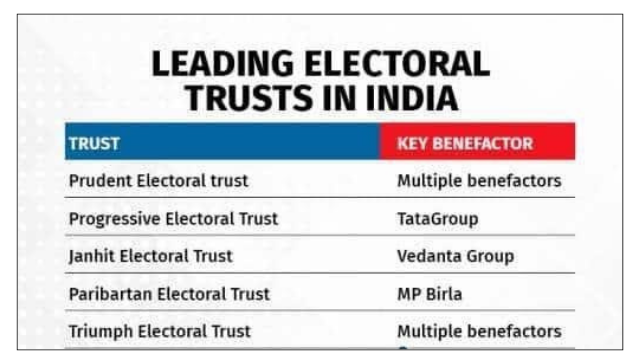
What is the legal status of election funding in India till now?
Electoral funding in India involves a mix of private donations, corporate contributions, and public funding. Some legal provisions that govern electoral funding are listed below:-
Representation of the People Act, 1951: This Act is one of the primary pieces of legislation that governs the conduct of elections in India. It includes provisions related to the declaration of expenses by candidates.
Income Tax Act, 1961: Provides provisions for tax relief to donors of political parties and to the parties themselves, if they adhere to certain conditions such as reporting contributions.
Foreign Contribution (Regulation) Act, 2010 (FCRA): Regulates foreign contributions to political parties, essentially barring parties from receiving foreign funds.

What Future models of election funding can be adopted in India?
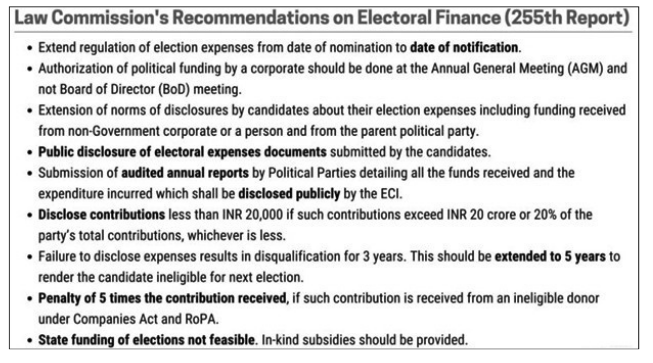
Enlist some examples and case studies of election funding models from around the world?
1. United States:
- In the United States, electoral funding is largely driven by private donations from individuals, corporations, and interest groups.
- Political Action Committees (PACs) and Super PACs can raise unlimited funds to support political candidates or causes, though with certain restrictions and disclosure requirements.
- The Citizens United Supreme Court decision in 2010 allowed corporations and unions to spend unlimited amounts on independent political expenditures, further shaping electoral funding dynamics.
2. United Kingdom:
- In the UK, political parties rely on a combination of public funding and private donations.
- Political parties receive public funding based on their electoral performance, known as "Short Money" for opposition parties and "Cranborne Money" for House of Lords opposition parties.
- Additionally, parties raise funds through individual donations, membership fees, and fundraising events, subject to certain regulations and transparency requirements.
3. Germany:
- In Germany, political parties receive public funding based on their electoral performance and parliamentary representation.
- Parties also raise funds through membership fees, individual donations, and fundraising events.
- Corporate donations are allowed but subject to strict disclosure requirements, and there are limits on the amount that can be contributed by single donors.
4. Canada:
- Electoral funding in Canada includes public subsidies for political parties based on their share of the popular vote in the previous election.
- Parties also rely on individual donations, membership fees, and fundraising activities to finance their campaigns.
- Corporate and union donations are banned at the federal level, and there are limits on individual contributions.
What can be other plausible models for India?
Electoral Trusts:
- Electoral trusts, established in 2013 by United Progressive Alliance (UPA), facilitated corporate donations to political parties, acting as a 'safe buffer' between them and donors.
- The Commission mandates disclosing donor and recipient information on its website.
State Funding of Elections:
- The Indrajit Gupta Committee (1998) endorsed state funding of elections, seeing “full justification constitutional, legal as well as on ground of public interest” in order to establish a fair playing field for parties with less money.
- The 1999 Law Commission of India report concluded that total state funding of elections is “desirable” so long as political parties are prohibited from taking funds from other sources.
- “Ethics in Governance”, a report of the Second Administrative Reforms Commission (2008) also recommended partial state funding of elections for the purpose of reducing “illegitimate and unnecessary funding” of elections expense.
What was the problem with electoral bonds?
Electoral bonds are money instruments like promissory notes that were launched in 2018.
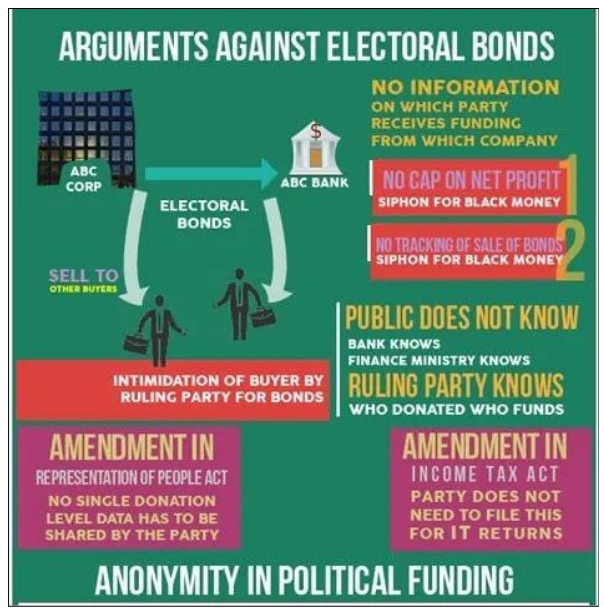
Issues in Electoral Bonds:
- The scheme allowed loss-making companies to make donations.
- This could have opened the door for shell companies to be formed with the purpose of channeling funds to political parties.
- In the case of electoral bonds, processes for public consultation, and discussions in Parliament were not followed.
- It raises fundamental issues in a democracy because any government with a majority can pass any Bill, which becomes law.
- The absolute non-disclosure of the source of political funding through electoral bonds promoted corruption.
What are the limits on spending in elections?
- Under Section 77 of the Representation of the People Act (RPA), 1951, every candidate shall keep a separate and correct account of all expenditure incurred between the date on which they have been nominated and the date of declaration of the result.
- All candidates are required to submit their expenditure statement to the ECI within 30 days of the completion of the elections.
- An incorrect account or expenditure beyond the cap can lead to disqualification of the candidate by the ECI for up to three years, under Section 10A of RPA, 1951.
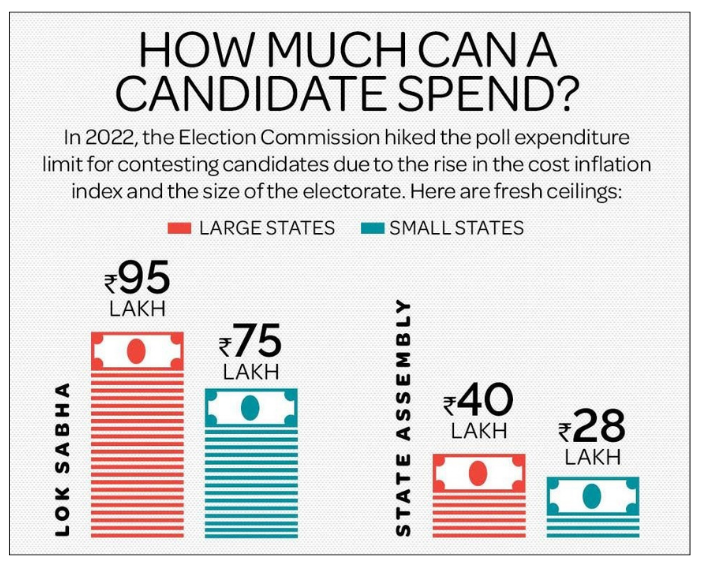
What is the size of electoral funding in India?
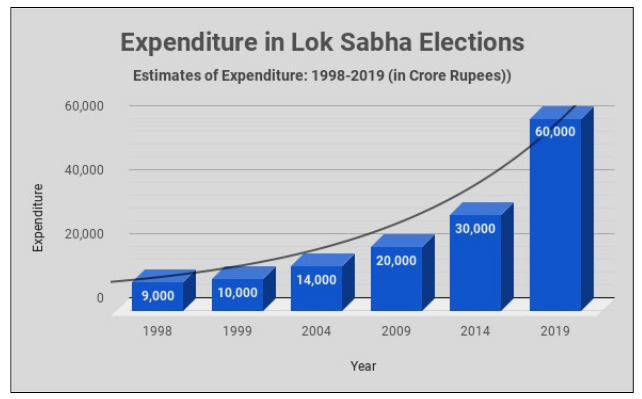
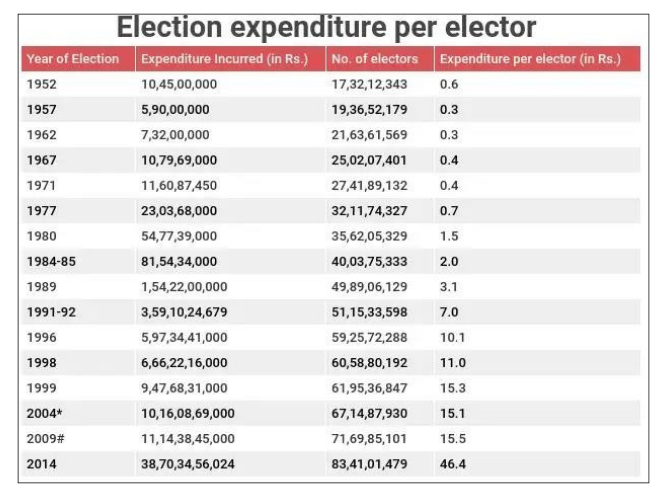
How big are Indian elections in terms of voters vis-a-vis other countries?
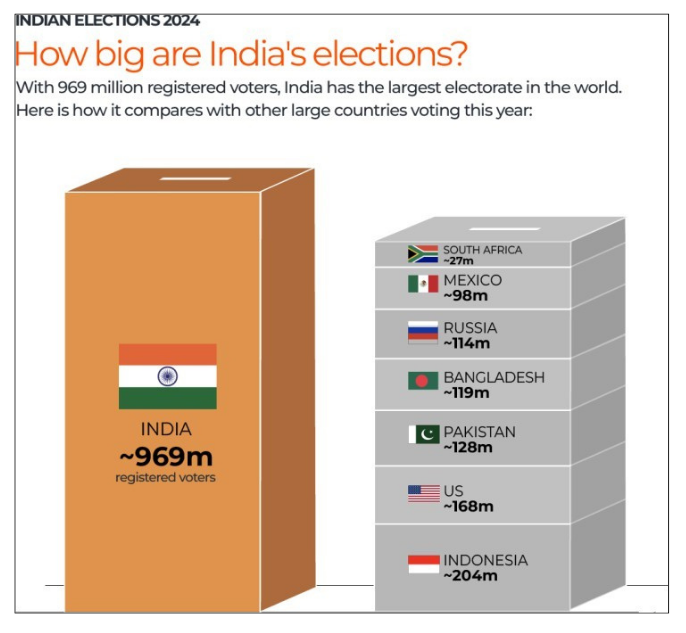
What steps has the election commission taken for voter awareness?
Voter Education
Systematic Voters’ Education and Electoral Participation ‘Greater Participation for a Stronger Democracy’
- Systematic Voters’ Education and Electoral Participation program, better known as SVEEP, is the flagship program of the Election Commission of India for voter education, spreading voter awareness and promoting voter literacy in India.
- Since 2009, we have been working towards preparing India’s electors and equipping them with basic knowledge related to the electoral process.
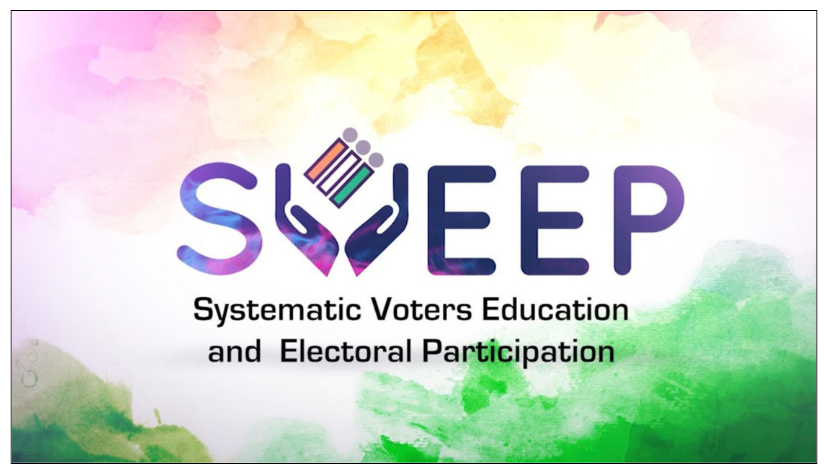
Voter Awareness Forums
- In an endeavor to extend electoral literacy to adult populations in government and non-government offices, private institutions and organizations, a special category of ELCs known as Voter Awareness Forums (VAFs) are being established.
- Voter Awareness Forums (VAFs) are informal forums for generating discussions and awareness around the electoral process, on the how, what and where of registration & voting, through the medium of real- time activities.
- Through VAFs in Government Departments, Government and Non- Government Organizations as well as in Corporates; the Election Commission of India aims to spread voter awareness and facilitate voter education.
What are the legal provisions surrounding electoral funding?
Legal provisions:
The legal framework to introduce the Electoral Bond Scheme
- On 14 May 2016, the Finance Act, 2016 came into force. It amended Section 2(1)(j)(vi) of the Foreign Contribution Regulation Act, 2010 (FCRA), which defines “foreign source”, to allow foreign companies who have a majority share in Indian companies to donate to political parties. Previously, foreign companies were prohibited from donating to political parties under the FCRA and the Foreign Exchange Management Act, 1999.
- On 31 March 2017, the Finance Act, 2017 amended the Representation of the People Act, 1951 (RoPA), the Reserve Bank of India Act, 1934, the Income Tax Act, 1961, and the Companies Act, 2013.
- Section 11 of the Finance Act, 2017 amended Section 13A of the Income Tax Act exempting political parties from keeping a detailed record of contributions received through electoral bonds.
- Section 135 amended Section 31 of the RBI Act. This permitted the Union government to “authorize any scheduled bank to issue electoral bonds.”
- Section 137 introduced a provision to Section 29C of RoPA, exempting political parties from publishing contributions received through electoral bonds in “Contribution Reports.” These reports disclose contributions received by parties “in excess of twenty thousand rupees” from companies and individuals.
- Section 154 amended Section 182 of the Companies Act, 2013 which removed the upper limit on how much a company could donate to a political party. Previously companies could only donate up to 7.5 percent of three years of the company’s net profits.
Is there a limit on spending during MCC?
The Election Commission has fixed the amounts that candidates can spend under various heads for their campaigns, meetings and the poll process.

Where is this money spent?

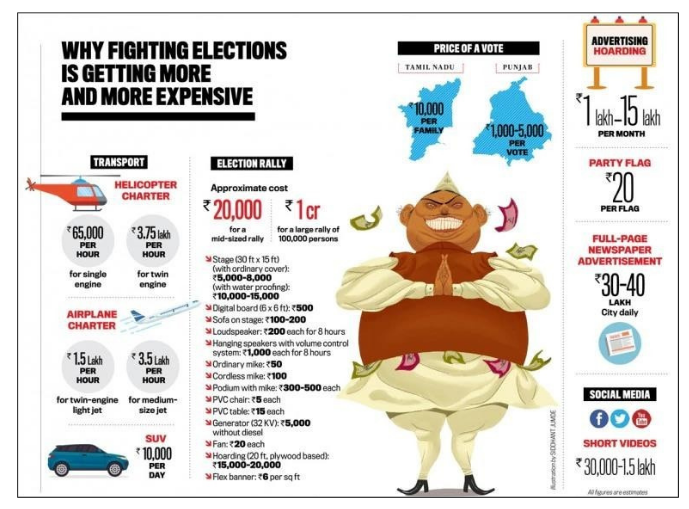
How is this topic relevant for UPSC CSE?
The topics SALIENT FEATURES OF RPA ACT, POWERS, FUNCTIONS OF CONSTITUTIONAL BODIES has been explicitly mentioned in Mains GS2 syllabus
Some Previous Years Mains Questions
Q1. To enhance the quality of democracy in India the Election Commission of India has proposed electoral reforms in 2016. What are the suggested reforms and how far are they significant to make democracy successful? (2017)
Some Questions From This Year And Previous Years Interview Transcripts
Board Suman Sharma mam (2024)
-
Electoral bonds are removed now, why?
-
So, was the system transparent before electoral bonds? What was the system?
-
And now, what will happen? How do you fund political parties?
Board TCA Anant sir (2022)
-
Transparency in political funding is also being compromised- like electoral bonds in India, what shall be done in this regard?
Board Smita Nagraj mam (2022)
-
What are electoral bonds ?
-
What are issues with it ?
-
How to bring transparency in electoral funding?
-
Other models like state sponsored